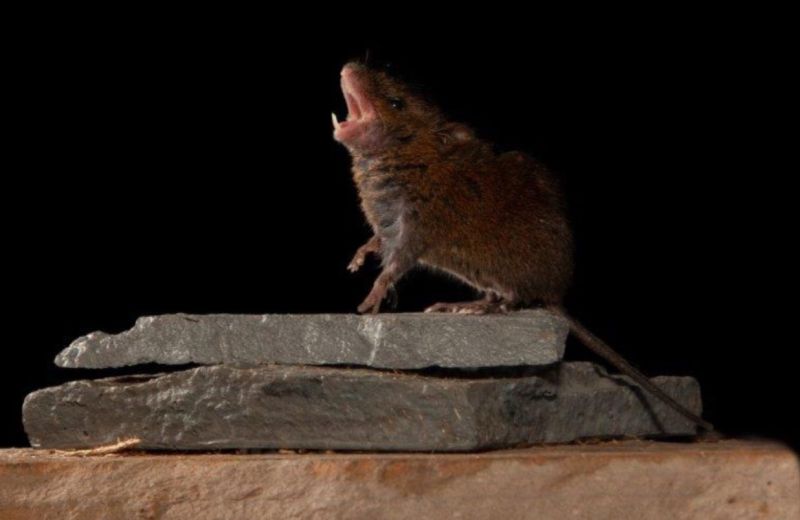Science
Related: About this forumSinging mice could offer clues about how human brains manage conversation
One part of the mouse's brain creates the song, another coordinates the duets.
JENNIFER OUELLETTE - 2/28/2019, 1:00 PM

This singing mouse species (Scotinomys teguina) thrives in the cloud forests of Costa Rica. Their songs could yield clues about how human brains accomplish the "turn-talking" that makes conversation possible.
High in the cloud forests of Costa Rica, there's a species of mouse that sings call-and-response duets, similar to the high-speed back and forth humans engage in with conversation. Now scientists have pinpointed the precise brain circuit responsible for this behavior, which may lead to fresh insights into how humans converse, according to a new paper in Science.
Co-author Michael Long of New York University's School of Medicine calls this conversational back and forth "turn talking," likening it to hitting a tennis ball back and forth over a net between two players. "If I were to summarize [the results] in one sentence, I'd say this is the first demonstration of the neural mechanisms that lead to coordinated vocal turn-talking in the mammalian brain," he said. "Our strong prediction from the mouse study is that a similar kind of vocal coordination center may exist in the human brain as well."
Long's lab specializes in the study of vocal communication, something at which human beings excel. We don't often stop to think about the intricate neural processing even a simple conversation requires. The pause time between when one speaker finishes and another begins—called "floor transfer time"—is just 200 milliseconds. But one in ten people experiences some form of communication disorder, whether due to a stroke or a developmental disorder like autism.
It's difficult to study this with humans because of the enormous complexity of the human brain. But certain animal species also exhibit turn-talking, including frogs, bottlenose dolphins, Bush crickets, and a few primates. Alas, the standard species of laboratory mouse (Mus musculus) does not exhibit this behavior. "They don't have vocal coordination in any meaningful way," said Long.
More:
https://arstechnica.com/science/2019/02/singing-mice-could-offer-clues-about-how-human-brains-manage-conversation/
Judi Lynn
(160,578 posts)These Singing Mice Take Turns During Duets, Offering Insights into Human Speech
By Roni Dengler | March 1, 2019 4:00 pm
High in the cloud forests of Costa Rica, a distinct chirping sound ripples across the landscape. This high-pitched staccato refrain trills not from birds, but mice. Now researchers have found that the tiny rodents making these sounds, known as Alston’s singing mice, take turns belting out their tunes much in the same way people take turns when they talk to each other. The discovery could shed light on communication problems in human speech.
Some 10 percent of the Americans suffer from a communication disorder. Those can stem from developmental disorders like autism, or stroke-related language deficits, for example.
“Disorders related to this [turn taking] process can be really devastating,” said Michael Long, a neuroscientist at the NYU School of Medicine, who led the new research. “Everything from developmental disorders like autism to stroke-related language deficits can affect this process.”
Take Turns
To get to the root of communication disorders in the brain, the scientists set out to find an animal that mimicked the vocal behaviors of humans. Long found it in Alston’s singing mice thanks to the keen observation of a graduate student working in his laboratory. Initially, researchers were studying the mice to figure out how the brain enables animals to produce song. Then, the graduate student noticed how the mice chattered to each other when the animals’ cages were close. The rodents appeared to be carrying on conversations. That casual observation hooked Arkarup Banerjee, a research fellow in Long’s laboratory, when he came to interview for a job. “I was completely enthralled,” he said.
Banerjee spent the next few years recording the mice’s songs. “All we needed was two microphones,” Banerjee explained. “It’s basically the glory of the animals that they do this robust behavior. We can just simply measure them using microphones.”
More:
http://blogs.discovermagazine.com/d-brief/2019/03/01/singing-mice-take-turns-talking/?utm_source=feedburner&utm_medium=feed&utm_campaign=Feed%3A%20DiscoverBlogs%20%28Discover%20Blogs%29#.XHxzAohKjIU